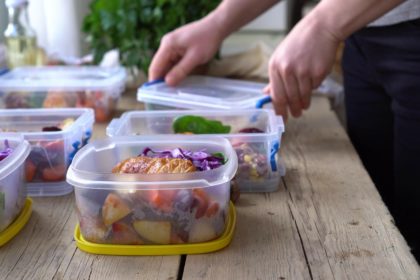Groceries seem to be getting more expensive with each passing day, and I dread making trips to the store, knowing a massive bill awaits. It can be especially tough to get the shopping done when you’re new to cooking for yourself. Thankfully, with careful planning, there are a few ways to ease the burden on your bank account. So, let’s review some meal planning tips on a budget.
Create a Financially Conscious Menu
The first hurdle to overcome when meal planning on a budget is figuring out what you’re going to eat. One way to narrow it down is to get an idea of what prices for proteins and grains are at your local grocery store.
Knowing the relative prices of various foods in your area is really helpful when putting together a meal plan. Typically, in the US, grains like pasta, rice, etc. are relatively inexpensive. When it comes to proteins, poultry is usually less expensive than red meat or pork. Produce prices can fluctuate a bit depending on the season, but fresh fruits are usually more pricey than fresh vegetables.
Even if it’s just relative to other food items, getting an idea of the cost is super helpful when meal planning. This is especially true if there is a meal you really want to make that may have some expensive ingredients. Swapping out expensive pulled pork for some shredded chicken may not give you the exact taste you were hoping for, but it will definitely help you stay under budget a bit better.
Buy Frozen
While not a solution for everything, there are a ton of proteins and produce you can buy more cheaply frozen: frozen chicken, frozen berries, frozen veggie mixes, etc. Frozen foods also store longer than fresh/ raw foods, which means you can also cut down on food waste. Less food wasted, in turn, also means less money wasted.
Buying frozen foods also has the advantage of coming with more options. Getting a small bag of vegetable mix rather than needing to buy an equal amount of each veggie and clean, cut, and cook them all just to get to about the same state the mix was already in saves money and time.
Stock Up on Staples
If you aren’t already, make sure to stock up on non-perishable staples—flour, sugar, salt, pasta, rice, etc. Things you can easily buy in bulk and store for a long time are things you will want to have on hand especially if you have any interest in cooking even simple meals.
Non-perishables are often the base of a lot of meal options, making them worth having on hand. It doesn’t hurt that once you have them you probably won’t need to restock very frequently. One less thing to buy the next time you have an idea for a meal you’d like to make.
Keep Sales Under Consideration
When planning a budget for meals, don’t sleep on sales! Your local grocery store probably puts out weekly coupons in the paper on top of in-store-only offers and free shopper loyalty programs.
If you aren’t part of a free member program, you can usually either sign up online or ask a clerk at checkout the next time you have to grab milk. It doesn’t hurt to check if you’re already part of a loyalty program compatible with your grocery store, too. If you’re part of a program at one store, you may be part of the same program at another chain owned by the same company. (For example, a big grocery chain in the Pacific Northwest is Fred Meyer, which Kroger owns. Enrolling in a program at either Fred Meyer or Kroger will mean you automatically get points or discounts at the other chain, too.)
More than just saving a few bucks on something you were already going to buy or racking up a few points that will take forever to be of any real use, knowing what is on sale can inform you of what meals to plan for the upcoming week. Sales on meat or items that are usually out of your budget are great for further stretching your dollars.
When it comes to actually finding what’s on sale, bigger grocery stores these days usually have an app that will let you see what is on sale. It’s a lot easier than the old days spent clipping physical coupons or trying to keep a look out for random coupon dispensers attached to store shelves.
Avoid Temptation with Curbside Pickup
Even when I know exactly what I want to get with a list prepared and everything, I still tend to end up with at least one or two impulse purchases. If you’re like me and have a hard time squashing that desire to get just one or two little things out of budget, take advantage of curbside pickup.
Ordering your groceries online ahead of time is more convenient for you from a time perspective. Plus, you get to avoid the temptation of those Reese’s pieces staring you down in the checkout line.
Make it From Scratch When You Can
While it may take some time, perfecting a few recipes you can easily make from scratch can be cost-effective. The more you make them, the more you’ll save over time. Especially if you can make recipes using mostly those bulk-bought, non-perishable staples we talked about earlier—things like biscuits, granola, bread, etc.
Turning those non-perishable ingredients into make-ahead batches that can be incorporated into several meals throughout the week is a huge time saver when you’ve got a busy schedule, too. For specific meal planning on a budget, check out these easy meal ideas that won’t break the bank. Budget Bytes is also a great tool with a huge variety of recipes and cost estimates per recipe and serving.




